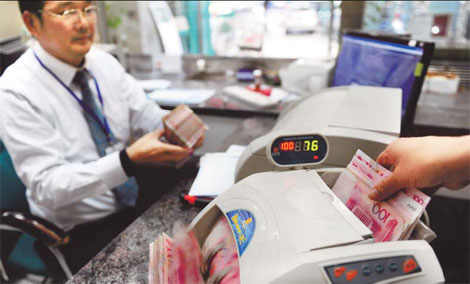Money
Decline in new yuan lending in January
Updated: 2011-02-16 07:51
By Gao Changxin (China Daily)
|
A bank employee counts renminbi at a bank in Qionghai, Hainan province. Chinese banks extended 1.04 trillion yuan ($157.8 billion) of new loans in January. Meng Zhongde / For China Daily |
SHANGHAI - Chinese banks extended 1.04 trillion yuan ($157.8 billion) of new loans in January amid the country's renewed efforts to tame excessive liquidity and rising inflation.
The figure was 318.2 billion yuan lower than a year ago, according to the People's Bank of China (PBOC), the central bank, on Tuesday. But economists said the country will not loosen its monetary stance as it still faces an uphill battle to cool consumer inflation, which hit 4.9 percent in January, slightly lower than forecast.
"The dip shows that the hikes in the reserve requirement ratio and the benchmark interest rate which began last year have to some extent taken effect," said Zuo Xiaolei, chief economist with China Galaxy Securities.
The PBOC raised interest rates last week for the third time since October and has hiked the reserve requirement ratio for banks seven times since the beginning of 2010.
However, the January lending figure is much higher than the 481 billion new yuan lending in December given the Chinese banks' pattern of front-loading lending at the start of each year.
As inflation hovers at 4.9 percent in January - a figure which could be even higher if it weren't for the adjustment of measuring methodology, analysts said any policy loosening would be impossible.
"The central bank is unlikely to loosen its monetary policy, which was changed to 'prudent' late last year from 'moderately loose', as China still faces high inflation expectations," Zuo said.
The country has been challenged by the problem of excess liquidity since last year, a situation which has resulted in surging inflation, after the government adopted the "moderately" loose monetary policy in 2008 to combat the fallout of the global financial crisis.
In 2010, new yuan loans rose to 7.95 trillion yuan, exceeding the government's target of 7.5 trillion yuan. Over the same period, inflation jumped 3.3 percent year-on-year, exceeding the official 3 percent target.
On Tuesday, the National Bureau of Statistics said consumer prices rose 4.9 percent in January from a year earlier. While that's lower than the 28-month-high of 5.1 percent in November, it is still 0.3 percentage points higher than December's 4.6 percent.
Wang Jianhui, chief economist with Southwest Securities, said while new lending slowed in January, the figure is still "relatively high", reflecting a strong appetite for lending among the banks.
Wang expects the central bank to continue to raise the reserve requirement ratio in the first half, and to raise the benchmark interest by 0.75 percent in total in three moves during the year.
"China faces a more complicated situation in fighting inflation this year, because apart from excessive liquidity, the strained food supply caused by a drought in northern China has also pushed up prices," said Wang.
Food prices are the main driver of China's inflation. They jumped 10.3 percent in January and have averaged more than 10 percent for the past four months.
In a warning issued recently, the UN Food and Agriculture Organization said that five of China's major wheat-growing provinces, which account for two-thirds of the country's output, are facing a severe drought, which could lead to increases in prices.
Also on Tuesday, the central bank said the growth in M2, the broad measure of money supply, slowed 2.5 percentage points to 17.2 percent by the end of January from 19.7 percent a month earlier.
Total yuan loans outstanding at the end of January rose 18.5 percent year-on-year to 48.35 trillion yuan., that's 1.4 percentage points lower than a month earlier.
China Daily
(China Daily 02/16/2011 page13)
Specials

Kremlin buddies
Dmitry Medvedev and Vladimir Putin inspect Olympic preparations.

Lantern Festival
The Lantern Festival is celebrated across China.

New York Fashion Week
Models line up before a show during New York Fashion Week.
